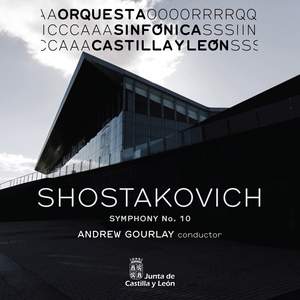Following what Gramophone Magazine described as a "splendidly alert inaugural release on the orchestra's own label", the Orquesta Sinfnica de Castilla y Len and its director, Andrew Gourlay, return with a powerful performance of Shostakovich's Symphony No 10.
The OSCyL's debut release was praised by MusicWeb International as "a really excellent calling card for this orchestra and their talented musical director excellent modern sound played with skill, insight and fluency"
The story behind Shostakovich's Tenth Symphony is, as with so much of that composer's output, veiled in mystery. It seems likely that Stalin's death emboldened Shostakovich to compose his Tenth Symphony "to convey human emotions and passions", an apparently innocuous phrase that had enormous implications in the context of a regime that demanded music for the People. Human emotions had been suppressed by the terror of state punishment; giving voice to these feelings was a radical act.
It is uncertain how reliable Shostakovich's memoirs, 'Testimony', are, but they offer a possible insight into this work; Shostakovich is reported to have said of the Tenth Symphony: "I couldn't write an apotheosis to Stalin, I simply couldn't. But I did depict Stalin in my symphony. I wrote it right after Stalin's death, and no-one has yet guessed what the symphony is about. It's about Stalin and the Stalin years. The second part, the scherzo, is a musical portrait of Stalin, roughly speaking. Of course, there are many other things, but that's the basis."
The symphony begins with a mournful, sinister first movement almost as long as the others combined. The Scherzo is a breathtaking blast of visceral energy. Shostakovich embeds two musical codes into the third movement: his musical signature, the "DSCH-motif", heard alongside a horn theme used to honour one of Shostakovich's students, Elmira Nazirova, with whom he was infatuated for several years. The finale acts as a summary of the symphony's emotional range, but concludes in a spirit of triumph.





